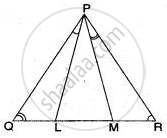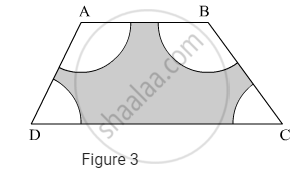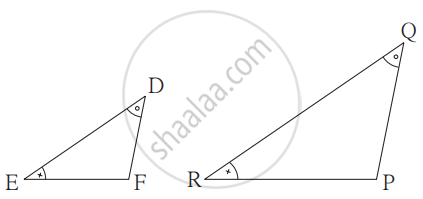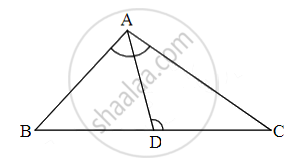Advertisements
Advertisements
Question
In ΔPQR, L and M are two points on the base QR, such that ∠LPQ = ∠QRP and ∠RPM = ∠RQP.
Prove that : (i) ΔPQL ∼ ΔRPM
(ii) QL. Rm = PL. PM
(iii) PQ2 = QR. QL.
Solution
(i) Consider
ΔPQL and ΔRPM
Since ∠PQL = ∠RPM
and ∠QPL = ∠RPM and
∠QPL = ∠PRM
By A. A. Criterion
ΔPQL ∼ ΔRPM
Hence Proved.
(ii) In ΔPQL ∼ ΔRPM
`"PQ"/"RP" = "OL"/"PM" = "PL"/"MR"`
then `"OL"/"PM" = "PL"/"MR"`
QL · MR = PL · PM.
Hence Proved.
(iii) In ΔPQR and ΔLQP
∠PQR = ∠LQP
PQ = PQ
Hence ΔPQR ∼ ΔLQP
`"QR"/"PQ" = "PQ"/"LQ"`
PQ2 = QR · QL.
Hence proved.
APPEARS IN
RELATED QUESTIONS
In figure, ABCD is a trapezium with AB || DC. If ∆AED is similar to ∆BEC, prove that AD = BC.
In Figure 3, ABCD is a trapezium with AB || DC, AB = 18 cm, DC = 32 cm and the distance between AB and DC is 14 cm. If arcs of equal radii 7 cm have been drawn, with centres A,B, C and D, then find the area of the shaded region.

If in ∆DEF and ∆PQR, ∠D ≅ ∠Q, ∠R ≅ ∠E then which of the following statements is false?

In the given figure, A – D – C and B – E – C seg DE || side AB If AD = 5, DC = 3, BC = 6.4 then Find BE.

Prove that the area of Δ BCE described on one side BC of a square ABCD is one half the area of the similar Δ ACF described on the diagonal AC.
Prove that the area of the triangle BCE described on one side BC of a square ABCD as base is one half of the area of similar triangle ACF described on the diagonal AC as base.
In ΔABC, point D divides AB in the ratio 5:7, Find: DE, If BC = 4.8cm
In a quadrilateral PQRS, the diagonals PR and QS intersect each other at the point T. If PT:TR = QT :TS = 1:2, show that ΔPTQ - DRTS
In a right-angled triangle ABC, ∠B = 90°, P and Q are the points on the sides AB and AC such as PQBC, AB = 8 cm, AQ = 6 cm and PA:AB = 1:3. Find the lengths of AC and BC.
In triangle ABC point D is on side BC (B−D−C) such that ∠BAC = ∠ADC then prove that CA2 = CB × CD

